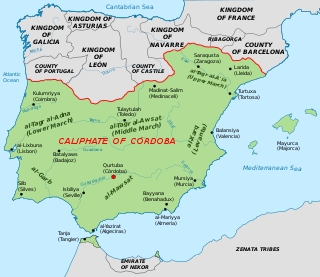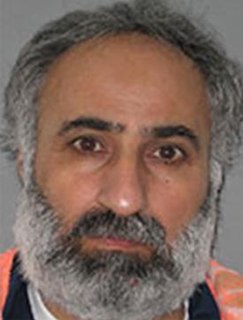Al rahman is the 55th chapter (surah) of the Qur'an.
Al rahman, Ar rahman, or other forms may also refer to:

Abd al-Rahman I, more fully Abd al-Rahman ibn Mu'awiya ibn Hisham ibn Abd al-Malik ibn Marwan (731–788) was the founder of the Arab dynasty that ruled the greater part of Iberia for nearly three centuries. Abd al-Rahman was a member of the Umayyad dynasty in Damascus, and his establishment of a government in Iberia represented a break with the Abbasids, who had overthrown the Umayyads in 750.
Nur al-Din is a male Arabic given name, translating to "light of the religion", nūr meaning "light" and dīn meaning "religion". More recently, the name has also been used as a surname.
Rahman may refer to:

The Mosque–Cathedral of Córdoba, officially known by its ecclesiastical name, the Cathedral of Our Lady of the Assumption, is the cathedral of the Roman Catholic Diocese of Córdoba dedicated to the Assumption of Mary and located in the Spanish region of Andalusia. Due to its status as a former Islamic mosque, it is also known as the Great Mosque of Córdoba, or the Mezquita.

The Al-Rahma Mosque is a mosque located on Hatherley Street in Toxteth, Liverpool, England, which can accommodate between 2,000 and 2,500 people and serves as the main place of worship and focus point for Liverpool's Muslim population, estimated at 25,000 people.
Rabia or Rabiah is the transliteration of two Arabic names written differently in Arabic text however they may be written similarly in the Latin script:
Uwais ibn Amir ibn Jaz' ibn Malik al-Qarani, also spelled Uways or Owais, was a Muslim from Yemen who lived during the lifetime of the Islamic prophet Muhammad. His burial place is in Raqqa, Syria. Although he lived during the lifetime of Prophet Muhammad, he never physically met him so he is not counted among the Companions of the Prophet. He however met Muhammad's companion Omar and is therefore seen as from among the Tabi'un. Among the Tabi'un he is specially known as Khayr al-Tabi'een and Sayyid al-Tabi'een Fi Zamanahu. His memorial shrine is in al-Raqqah, Syria. It was destroyed by ISIS in 2013.
Aqsa, Aksa, al-Aksa or al-Aqsa usually refer to either:
Rahman, Raḥmān) is an Arabic male name meaning "gracious" or "merciful". With nisba, the name becomes Rahmani, means "descendant of the gracious one" and is used as a surname. In Islam, Ar-Rahman is one of the Names of God.

Abdelrahman or Abd al-Rahman or Abdul Rahman or Abdurrahman or Abdrrahman is a male Arabic Muslim given name, and in modern usage, surname. It is built from the Arabic words Abd, al- and Rahman. The name means "servant of the most gracious", ar-Rahman being one of the names of God in the Qur'an, which give rise to the Muslim theophoric names.
Abdur Razzaq is a male Muslim given name, and in modern usage, surname. It is built from the Arabic words Abd, al- and Razzaq. The name means "servant of the all-provider", Ar-Razzāq being one of the names of God in the Qur'an, which give rise to the Muslim theophoric names.
Rahma is an Arabic name and may refer to:
Abdur Rauf is a male Muslim given name. It is built from the Arabic words Abd, al- and Rauf. The name means "servant of the Lenient One", Ar-Ra'ūf being one of the names of God in the Qur'an, which give rise to the Muslim theophoric names.

The Caliphate of Córdoba was an Islamic state, ruled by the Umayyad dynasty from 929 to 1031. Its territory comprised Iberia and parts of North Africa, with its capital in Córdoba. It succeeded the Emirate of Córdoba upon the self-proclamation of Umayyad emir Abd ar-Rahman III as caliph in January 929. The period was characterized by an expansion of trade and culture, and saw the construction of masterpieces of al-Andalus architecture.
The demolition or burning of Masjid al-Dirar , or the Mosque of Dissent, is mentioned in the Qur'an. Masjid al-Dirar was a Medinian mosque that was erected close to the Quba' Mosque and which the Islamic prophet Muhammad initially approved of but subsequently had destroyed while he was returning from the Expedition to Tabouk. In the main account narrated by the majority of scholars, the mosque was built by twelve disaffected men from the Ansar on the commands of Abu 'Amir al-Rahib; a Hanif who refused Muhammad's invitation to Islam and instead fought along with the Meccan non-Muslims against Islam in the Battle of Uhud. Abu 'Amir reportedly urged his men to establish a stronghold and prepare whatever they can of power and weapons as he promised and insinuated to them that he will lead an army, backed by Heraclius, to fight Muhammad and his companions, and defeat his message by expelling him from Medina. Ahmad ibn Yahya al-Baladhuri also relates that the men, who built the Al-Dirar mosque "for mischief and for infidelity and to disunite the Believers" refused to pray in Masjid al-Quba claiming that it was built in a place where a donkey used to be tied up.
Islah or Al-Islah is an Arabic word usually translated as "reform", in the sense of "to improve, to better, to correct something and removing vice or to put something into a better position."

Ar-Rahman Mosque is a contemporary mosque in Aleppo, Syria, located on King Faisal Street. It was opened in 1994 and features a combined style of the early Umayyad architecture and modern mosques.

Abdulrahman Mustafa al-Qaduli, better known by his noms de guerre Abu Ala al-Afri and Abu Ali al-Anbari, was the governor for territories held by the Islamic State of Iraq and the Levant (ISIL) in Syria. Considered the ISIL second-in-command, he was viewed as a potential successor of ISIL leader Abu Bakr al-Baghdadi.

The al-Rahman Legion is a Syrian rebel group that operated in Eastern Ghouta, in the outskirts of Damascus, and in the eastern Qalamoun Mountains. It was the main rebel group in Jobar, and was backed by Qatar. The group's leader is Abdul al-Nasr Shamir, a captain from rural Homs who defected from the Syrian Army in early 2012. The Legion has been described as an "Islamist" or as a non-jihadi/non-Salafi "political Islamist" organisation. It describes itself as "a revolutionary military entity aiming for the downfall of the Syrian regime," but does not seek to turn Syria into an Islamic state. In 2016, it was described as "one of the oldest standing opposition factions in Damascus and maintains high levels of local legitimacy and support." Under a surrender agreement, over 5,000 of its fighters and associated civilians left Damascus for northwestern Syria in March 2018.

The Alcázar of the Caliphs or Caliphal Alcázar, also known as the Umayyad Alcázar and the Andalusian Alcazar of Cordoba, was a fortress-palace (alcázar) located in Córdoba, in present-day Spain. It was the seat of the government of Al-Andalus and the residence of the emirs and caliphs of Córdoba from the 8th century until the 11th century and the residence of local Muslim governors from the 11th century until the Christian conquest in 1236. The site was composed of heterogeneous constructions ranging from the private residences of the rulers and their households to the government offices and administrative areas. Today, only minor remains of the palace have survived, including the Caliphal Baths which have been converted into a museum. The rest of the site is occupied by later structures including the Alcázar de los Reyes Cristianos, the Episcopal Palace, the Seminary of San Pelagio, and the Campo Santos de los Mártires public square.